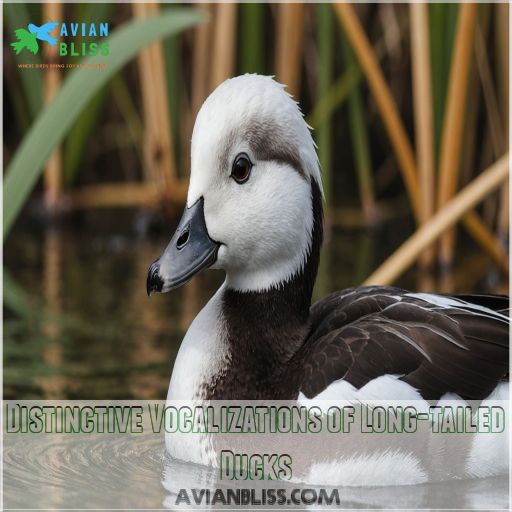This site is supported by our readers. We may earn a commission, at no cost to you, if you purchase through links.

These Arctic specialists sport striking plumage and can dive deeper than most ducks, plunging up to 200 feet!
They’re vocal creatures too, with males belting out yodeling calls that’ll make you chuckle.
Long-tailed ducks are masters of adaptation, switching between tundra and open ocean with ease.
But life’s not all smooth sailing for these sea ducks – they face threats from fishing nets to climate change.
Curious about how they’ve earned the nickname "old squaw" or why their bills are so unique? Stick around for some fascinating insights into these remarkable waterfowl.
Table Of Contents
- Key Takeaways
- Long-tailed Duck: an Overview
- Identification of Long-tailed Ducks
- Distinctive Vocalizations of Long-tailed Ducks
- Breeding and Nesting Habits
- Impressive Diving Abilities of Long-tailed Ducks
- Diet and Feeding Strategies
- Migration Patterns of Long-tailed Ducks
- Long-tailed Duck Predators and Threats
- Conservation Efforts for Long-tailed Ducks
- Unique Adaptations of Long-tailed Ducks
- Frequently Asked Questions (FAQs)
- What is another name for Long-tailed Duck?
- Where do Long-tailed Ducks winter?
- Are Long-tailed Ducks rare?
- What are some interesting facts about Long-tailed Ducks?
- What is the historical name for Long-tailed Ducks?
- How do Long-tailed Ducks navigate in rough waters?
- What is the average lifespan of a Long-tailed Duck?
- Do Long-tailed Ducks form mixed flocks with other species?
- How do climate changes affect Long-tailed Duck populations?
- Conclusion
Key Takeaways
- You probably didn’t know these diving ducks, aptly named for their long tails, can plunge over 200 feet, out-swimming the competition and leaving other ducks in their bubbles. They’re like the Olympians of the waterfowl world!
- Despite their dramatic plumage and acrobatic dives, long-tailed ducks face serious threats. From fishing nets to climate change, these resilient birds need all the help they can get to keep their heads above water.
- These ducks aren’t just eye-candy; they’ve got a vocal repertoire that might just make you chuckle. Male long-tailed ducks yodel their way into attracting mates, turning every courtship into a quack-erous concert.
- They’re not fair-weather fowl either. Long-tailed ducks are globe-trotters, navigating from the frosty Arctic tundra to open oceans with ease, proving they’re made for both the runway and the migration highway.
Long-tailed Duck: an Overview
Explore the fascinating world of the Long-tailed Duck, a remarkable diving duck with unique adaptations and widespread habitats across northern regions.
You can’t help but admire their striking appearance and melodious calls, making them a standout among waterfowl.
Physical Characteristics
Meet the long-tailed duck, a stylish sea duck known for its distinctive tail feathers.
Males sport long tails and striking plumage that would outshine a northern pintail or harlequin duck any day.
Females, less flashy, prefer subtle pale hues.
With a bill designed for diving and eyes sharp enough to spot the finest shellfish, these ducks are true Arctic adventurers .
Habitat and Range
The long-tailed duck’s habitat and range is truly impressive.
These hardy birds thrive in the Arctic tundra, breeding along the coasts of North America, Greenland, and Eurasia.
In winter, they flock to the open ocean, Great Lakes, and protected bays, braving frigid waters and sea ice.
Their circumpolar distribution is a clear indication of their adaptability:
- Breeding in the high Arctic
- Wintering along ocean coasts and large inland waters
- Migrating vast distances between summer and winter homes
- Thriving in diverse habitats, from tundra to open sea
Behavioral Traits
You might find Long-tailed Ducks’ behavioral traits fascinating as they display intriguing territoriality and flock dynamics.
Known for their energetic courtship displays, these ducks serenade potential mates with musical calls.
Their impressive parental care includes tending young who quickly master swimming underwater.
Foraging underwater, they feast on aquatic insects, fish eggs, and small fish—often adding a side of plant matter .
Conservation Status
Long-tailed Ducks face challenges galore! They’ve slipped onto the IUCN Red List due to population declines.
Their threats include:
- Getting tangled in fishing nets
- Climate change impacts
- Oil pollution hazarding their habitats
- A need for stronger conservation efforts
- Ongoing research to aid recovery
Every bit counts when protecting these diving ducks and their future outlook.
Identification of Long-tailed Ducks
In identifying Long-tailed Ducks, you’ll notice how the males sport a dramatic transformation from their striking breeding plumage to a subtler winter look.
Males are the flashy show-offs of the duck world, while females and juveniles keep it casual with understated colors.
Male Plumage in Breeding Season
Male Long-tailed Ducks, dazzling in breeding season, sport mostly black plumage with a striking white face patch and elongated tail feathers—nature’s own stylish accessory.
As if ready to strut a fashion runway, their look is both dramatic and eye-catching.
| Feature | Description | Emotion Elicited |
|---|---|---|
| Face Patch | White, striking | Amazement |
| Body Color | Mostly black | Boldness |
| Tail Feathers | Long, elegant | Drama |
| General Effect | Stunning contrast | Captivation |
Male Plumage in Winter
As breeding season fades, male Long-tailed Ducks swap their dark summer elegance for winter camouflage—white plumage with a touch of brown and gray.
Like nature’s snowbirds of North America, this seasonal change aids their survival.
Their stunning, crisp look delights bird watchers, while these intrepid diving ducks continue their journey through remote waters .
Female Appearance
Female long-tailed ducks don an understated elegance, sporting a gray plumage with white accents around their eyes and nape, making them winter’s gentle palette.
Observe these features:
- Color Contrast: The white face dramatically contrasts with a dark crown.
- Size Comparison: Slightly smaller than their male counterparts.
- Plumage Variations: Seasonal shifts in color echo autumn’s charm.
Juvenile Characteristics
As young Long-tailed Ducks grow, their plumage changes from a mottled brown-and-white pattern to the striking adult coloration. Juveniles sport a compact, rounded head and a stubby bill, lacking the male’s extravagant tail feathers. While less distinctive, these ducklings are still fascinating to observe as they learn to dive and forage alongside their attentive mothers.
| Juvenile Plumage | Growth Stages | Molting Patterns | Distinguishing Features |
|---|---|---|---|
| Mottled brown-and-white | Compact, rounded head | Gradual change to adult plumage | Stubby bill, no long tail feathers |
| Less vibrant than adults | Steady increase in size | Synchronized with breeding cycle | Reliance on parental care |
| Juvenile Plumage | Growth Stages | Molting Patterns | Distinguishing Features |
|---|---|---|---|
| Camouflage for protection | Develop diving and foraging skills | Seasonal changes in coloration | Vulnerable to predators and habitat loss |
| Resemble females in appearance | Reach full size by first winter | Adaptation to marine environment | Importance of conservation efforts |
Distinctive Vocalizations of Long-tailed Ducks
When you listen to Long-tailed Ducks, you’ll hear their fascinating and melodious calls, especially the males’ musical "ow-owdle-ow" during courtship.
These vocalizations are charming but also play a key role in their social interactions, making them an important part of their unique community life.
Male Courtship Calls
Imagine a group of male long-tailed ducks, each trying to out-sing the other with their charming courtship calls—a musical "ow-owdle-ow" that echoes through the air.
- Unique Melody: The song is both rhythmic and mellow.
- Purposeful Sound: Attracts females during winter courtship.
- Ritual Display: Adds flair to their gatherings.
- Vocal Behavior: Resembles an avian opera! .
Female Vocalizations
Listening to a female Long-tailed Duck, you might catch the gentle, though sporadic, calls used in brood communication and chick distress alerts.
Often understated compared to their male counterparts, these ducks don’t cluck around when it comes to nest defense.
With a calm and authoritative demeanor, they signal alarm like seasoned guardians, ensuring their young are well-protected .
Flock Communication
Imagine a bustling group of Long-tailed Ducks, like a lively family reunion.
Their distinctive calls play a key role in flock dynamics, serving as alarm calls and aiding in migration coordination.
These vocalizations create social signaling that keeps the group connected, especially during group foraging.
It’s a vibrant concert of communication, ensuring everyone’s in sync .
Breeding and Nesting Habits
Discover the fascinating world of Long-tailed Ducks’ breeding habits, where courtship looks more like a dance competition, and nests get a cozy feather lining.
Egg-laying strategies and the duckling daycare that follows are also fascinating aspects of their breeding habits.
Courtship Rituals
You’ll often see long-tailed ducks engaging in interesting courtship rituals. Males pull out all the stops to woo females, showcasing their stunning plumage and performing intricate displays.
Watch for the "grunt-whistle," where males rise from the water, whistle, and grunt in quick succession . Females join in with "nod-swimming," signaling their interest and encouraging more displays.
These rituals typically kick off in midwinter, heating things up as temperatures drop .
Nest Construction
The art of nest-building is a delicate process for long-tailed ducks.
These resourceful birds choose dry ground close to water, often partially hidden under low vegetation or among rocks.
They create a shallow depression, lining it with available plant material and a generous amount of their own down feathers .
This cozy nest provides the perfect sanctuary for their precious eggs, blending seamlessly with the surrounding tundra landscape.
Egg Laying and Incubation
Once the nest’s cozy, it’s time for egg-laying and incubation.
Female long-tailed ducks get down to business, laying 6-9 eggs on average .
- The first egg gets a snug grass and sedge blanket
- Down feathers join the party after egg number two
- Mama duck settles in for a 24-29 day incubation period
Talk about dedication! These tough birds brave the Arctic chill to make sure their future paddling pals make it into the world.
Duckling Care
Raising long-tailed duck ducklings is no small feat!
These tiny bundles of fluff require constant care and protection.
Mom’s got her flippers full, tending to her brood and teaching them key survival skills.
She’ll guide them to shallow waters, helping them forage for insects and small crustaceans .
Remember, these little guys aren’t waterproof yet, so supervised swims are a must until they’re about six weeks old .
Impressive Diving Abilities of Long-tailed Ducks
You might think ducks are just surface swimmers, but long-tailed ducks will surprise you with their underwater prowess.
These remarkable birds can plunge to astonishing depths, outperforming all other duck species with their impressive diving abilities.
Diving Depth and Duration
After nesting, you’ll find long-tailed ducks showcasing their impressive diving skills. These aquatic acrobats can plunge to astonishing depths of up to 200 feet . That’s deeper than any other duck species! Their remarkable lung capacity and physiological adaptations allow them to stay submerged for extended periods.
- They can withstand intense underwater pressure
- Their metabolism slows down to conserve oxygen
- Their bodies are streamlined for efficient movement
Underwater Propulsion Techniques
Long-tailed ducks are masters of underwater propulsion.
You’d be amazed by their wing-powered swimming and foot-propelled diving techniques.
These birds are like underwater acrobats, using their wings to "fly" through the water with incredible hydrodynamic efficiency.
Their streamlined body shape plays a key role, allowing them to zip through the depths with ease.
While many diving ducks stick to shallow waters, long-tailed ducks are known for their impressive deep-diving capabilities .
Adaptations for Deep Diving
You’ve seen how long-tailed ducks propel themselves underwater, but their deep-diving prowess goes beyond that.
These aquatic acrobats have evolved some nifty tricks to plunge to astonishing depths.
With enhanced lung capacity and a streamlined body, they’re built for the deep.
Their wings double as underwater fins, and a diving reflex slows their heart rate.
It’s like they’ve got built-in scuba gear!
Diet and Feeding Strategies
You might think Long-tailed Ducks are picky eaters, but they’re actually quite versatile in their diet.
These aquatic gourmets have a menu that changes with the seasons, and they’ve got some pretty clever tricks up their feathers when it comes to finding food.
Primary Food Sources
These remarkable divers aren’t picky eaters! Long-tailed ducks feast on a smorgasbord of marine life.
Their main course? Invertebrates like crustaceans and mollusks .
But they’re not above nabbing small fish or even fish eggs when the opportunity arises .
With their impressive diving skills, they can pluck tasty morsels from the ocean floor up to 200 feet deep. Talk about a deep-sea buffet!
Seasonal Dietary Variations
Three distinct seasons shape the long-tailed duck‘s diet, showcasing their adaptability.
During winter, they’re marine gourmets, feasting on crustaceans, clams, and small fish in coastal waters (Source).
Come breeding season, they switch gears, favoring insects and aquatic plants in arctic wetlands .
Autumn brings a mix of both as they prepare for migration.
- Diving deep for juicy blue mussels in icy winter waters
- Snatching buzzing mosquitoes mid-air over summer tundra ponds
- Slurping up tiny herring eggs from seaweed beds in spring
Foraging Techniques
Picture a long-tailed duck diving deeper than its ducky peers, clocking in at astounding diving depths.
It’s a master of underwater maneuvers, using its feet to propel as it eyes prey like mollusks and crustaceans.
Seasonal shifts impact food availability, leading to playful competition among flocks.
In winter, it feasts on ocean treasures, adapting daily.
Migration Patterns of Long-tailed Ducks
You’re about to dive into the remarkable migration patterns of Long-tailed Ducks.
From their Arctic breeding grounds to their southern wintering areas, these hardy birds cover impressive distances.
They showcase their adaptability and endurance in the face of changing seasons.
Breeding Grounds
In the Arctic, long-tailed ducks set up shop for their summer breeding grounds.
You’ll find these hardy birds nesting in both low-lying tundra and hilly areas, even at the edges of northern forests. They’re not picky, as long as there’s open water nearby.
Nest site selection is essential for breeding success, with females opting for dry ground close to water, often tucked away under low vegetation or among rocks.
Wintering Areas
Long-tailed ducks’ winter wonderland stretches far and wide.
You’ll find these hardy birds braving the icy waters of the Bering Sea, Hudson Bay, and the Great Lakes.
They’re not picky about their winter digs, happily bobbing in oceans, large lakes, or even among pack ice.
Climate change and overfishing are reshaping their winter havens, though, so keep an eye out for these resilient divers adapting to new haunts.
Migration Routes and Timing
You’ve seen where these ducks spend their winters, but their migration patterns are equally fascinating.
Long-tailed ducks are late fall migrants and early spring travelers .
They’re not your typical snowbirds!
These high-flyers often soar far above land, with some preferring coastal routes.
It’s a twist on the usual migration pattern, as they head north for winter and south for summer .
Talk about marching to the beat of their own drum!
Long-tailed Duck Predators and Threats
You might be surprised to learn that the stunning long-tailed duck faces a variety of threats both above and below the water’s surface.
From avian predators and cunning foxes to human activities and climate change, these hardy birds navigate a gauntlet of challenges in their quest for survival.
Natural Predators
Now that we’ve explored the long-tailed duck’s impressive journeys, let’s look at the dangers they face.
These hardy birds aren’t immune to nature’s perils.
Foxes, gulls, and crows are their main natural predators .
You might spot a jaeger swooping down or a harrier hunting for an easy meal.
Even underwater, they’re not safe – pike can pose a threat to unsuspecting ducklings.
It’s a tough world out there for these feathered friends!
Human-induced Threats
While natural predators pose a risk, human activities have become the biggest threat to long-tailed ducks.
These beautiful birds face a gauntlet of dangers in their marine habitats.
Gillnet fishing is a major culprit, with an estimated 90,000 seabirds, including long-tailed ducks, dying annually as bycatch in the Baltic Sea alone .
Oil spills and chronic pollution from shipping routes also take a heavy toll on these vulnerable creatures.
Climate Change Impacts
Beyond human-induced threats, climate change is casting a long shadow over long-tailed ducks. These Arctic-adapted birds are facing a perfect storm of challenges:
- Sea ice decline disrupting their wintering grounds
- Shifting habitats altering breeding sites
- Food scarcity impacting their survival
As temperatures rise, these ducks are caught between a rock and a hard place. Their breeding success is tied to lemming populations, which are also affected by climate change .
It’s like Mother Nature’s throwing curveballs at our feathered friends!
Conservation Efforts for Long-tailed Ducks
You’ll be fascinated to learn about the ongoing efforts to protect the vulnerable Long-tailed Duck.
From population tracking to habitat preservation and global teamwork, conservationists are working hard to make sure these remarkable diving ducks continue to grace our waters for generations to come.
Population Monitoring
You’ve seen how predators and human activities impact long-tailed ducks. Let’s explore how scientists keep tabs on these fascinating birds.
Tracking their population isn’t easy – they breed in remote Arctic areas and winter in tricky marine environments .
Traditional surveys often miss the mark, as these ducks nest later than other species.
But don’t worry! Researchers are developing new aerial survey methods to fill these monitoring gaps.
Habitat Protection Initiatives
Habitat protection initiatives are ramping up to safeguard long-tailed ducks. Conservation groups are focusing on preserving coastal wetlands and tundra breeding grounds .
They’re also tackling threats like coastal development and oil spills.
Climate change mitigation efforts are underway to protect the arctic habitats these ducks rely on.
Fishing gear modifications are being implemented to reduce accidental entanglements.
It’s a race against time, but every little bit helps these remarkable sea ducks thrive.
International Cooperation
Conservation efforts for long-tailed ducks don’t stop at borders.
These globe-trotting birds require a united front.
Countries collaborate on tracking population trends and conducting joint research projects.
Migratory bird agreements protect these feathered travelers along their journey.
International funding fuels habitat restoration efforts, giving these ducks a fighting chance.
It’s like a global duck support group – everyone’s pitching in to keep these charming birds afloat!
Unique Adaptations of Long-tailed Ducks
You’ll be amazed by the long-tailed duck’s incredible adaptations that help it thrive in harsh environments.
From their cold-weather survival tricks to their specialized bill structure and unique social behaviors, these remarkable birds have evolved some truly impressive features.
Cold Weather Survival Mechanisms
The long-tailed duck, a master of Arctic survival, boasts impressive cold weather adaptations.
These hardy birds have evolved to thrive in frigid conditions, making them the most arctic-adapted of all ducks .
- Winter plumage for enhanced insulation
- Substantial fat reserves for energy
- Multiple insulation layers to trap warmth
- Specialized circulation to prevent frostbite
- Adaptations for cold water diving
These feathered champions of the north truly know how to beat the cold!
Specialized Bill Structure
You’d be amazed by the long-tailed duck’s specialized bill structure.
It’s not just for show – this clever adaptation helps these hardy birds thrive in harsh Arctic environments.
Their stubby, slightly upturned bills are perfect for snatching up mollusks, crustaceans, and small fish underwater .
This unique design allows them to efficiently feed at depths up to 200 feet, making them the diving champions of the duck world .
Social Behavior Adaptations
Beyond their specialized bills, long-tailed ducks have fascinating social lives. These chatty birds form tight-knit flocks, earning their old nickname ‘Oldsquaw’ .
In breeding season, males defend small territories with head-shaking and bill-tossing displays . Females often nest in cozy clusters, creating a duck neighborhood.
During winter, they’ll gather in massive flocks of up to 4.5 million birds, turning the Baltic Sea into a lively duck party .
Frequently Asked Questions (FAQs)
What is another name for Long-tailed Duck?
You might think its name says it all, but there’s more to this chatty waterfowl!
Formerly known as "Oldsquaw" (Source), the Long-tailed Duck‘s also called "Pato Havelda" in Spanish and "Harelde kakawi" in French .
It’s quite the multilingual quacker!
Where do Long-tailed Ducks winter?
Long-tailed Ducks spend winters along ocean coasts, from Oregon to North Carolina, and on the Great Lakes.
They’re often found far out at sea, forming large flocks in protected bays and northern waters like the Bering Sea .
Are Long-tailed Ducks rare?
While not rare globally, these sea ducks have faced significant declines. Their population has dropped by 80% in Alaska since 1957 , though numbers have stabilized recently. They’re still abundant, with millions worldwide .
What are some interesting facts about Long-tailed Ducks?
Picture a master diver of the Arctic seas.
They’re vocal chatterboxes, earning them the old nickname "Oldsquaw".
These melodious ducks can plunge over 200 feet deep , sporting striking winter plumage and comically long tails.
What is the historical name for Long-tailed Ducks?
You’ve probably heard these chatty sea ducks called "Oldsquaws" in older texts.
It’s a historical name that’s since been replaced, reflecting changing sensibilities.
These deep-diving beauties now sport the more descriptive moniker of Long-tailed Duck .
How do Long-tailed Ducks navigate in rough waters?
Long-tailed ducks are masters of rough seas.
They’ve adapted to dive deep and use their wings underwater, propelling themselves like underwater flyers .
This unique technique allows them to navigate turbulent waters with grace and efficiency .
What is the average lifespan of a Long-tailed Duck?
Ah, the resilient long-tailed duck – a true Arctic survivor!
These feisty fowl can live a remarkable 12 to 14 years in the wild, defying the odds and thriving in their icy domain.
Do Long-tailed Ducks form mixed flocks with other species?
Considerably sociable, these ducks sometimes mix with other species during migration or wintering.
While not as chummy as some waterfowl, they may still join a mixed-species group, benefiting from shared foraging and safety .
How do climate changes affect Long-tailed Duck populations?
With climate change, temperature shifts and habitat loss affect breeding and wintering grounds, posing a challenge for Arctic-adapted ducks.
It’s worth noting that up to 30% of North American populations winter near Nantucket, potentially altering migration patterns .
Conclusion
Remarkably, the long-tailed duck’s name barely hints at its extraordinary life. You’ve got a bird that plunges impressively deep and serenades the Arctic with quirky yodels, proving it’s not just about appearances.
These ducks have mastered adaptation—navigating from icy tundras to open oceans.
While threats loom, these ducks have mastered adaptation—navigating from icy tundras to open oceans. By understanding their lives and challenges, you can appreciate these fascinating sea ducks’ resilience and the global efforts needed to secure their future. Keep an eye out for a new perspective on the humble long-tailed duck.













